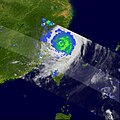|
Vikidia currently has 4,627 articles. Improve it! |
|
Join Vikidia: create your account now and improve it! |
File:Saomai 2006-08-10 0558Z TRMM.jpg
Jump to navigation
Jump to search


Size of this preview: 600 × 600 pixels. Other resolutions: 240 × 240 pixels | 480 × 480 pixels | 768 × 768 pixels | 1,024 × 1,024 pixels.
Original file (1,024 × 1,024 pixels, file size: 727 KB, MIME type: image/jpeg)
File history
Click on a date/time to view the file as it appeared at that time.
| Date/Time | Thumbnail | Dimensions | User | Comment | |
|---|---|---|---|---|---|
| current | 05:55, 6 September 2006 |  | 1,024 × 1,024 (727 KB) | wikimediacommons>Coredesat | TRMM satellite image showing rainfall distribution within Typhoon Saomai as it makes landfall in Zhejiang, China. Image is from the [http://earthobservatory.nasa.gov/NaturalHazards/natural_hazards_v2.php3?img_id=13772 NASA Earth Observatory]. |
File usage
The following page uses this file:

